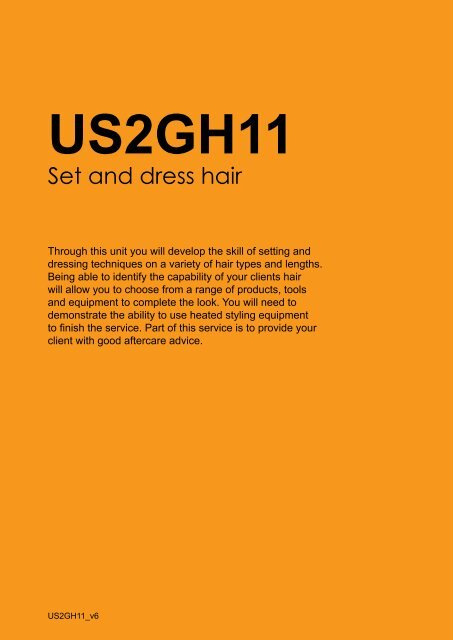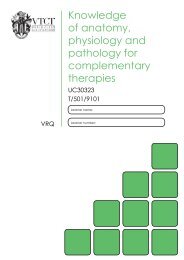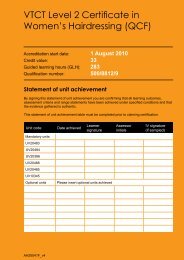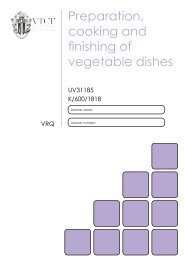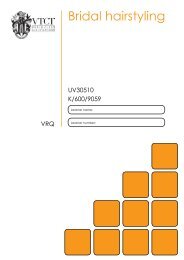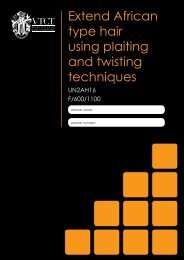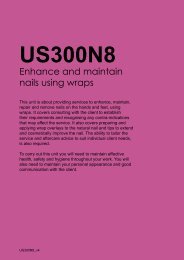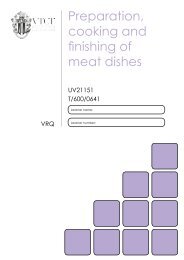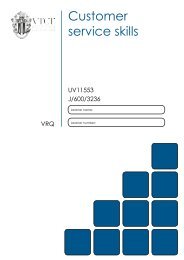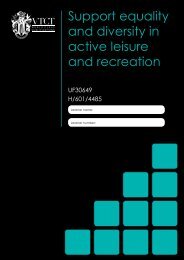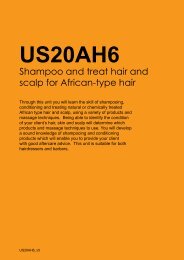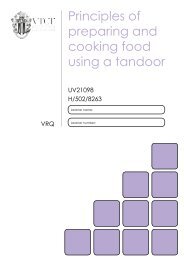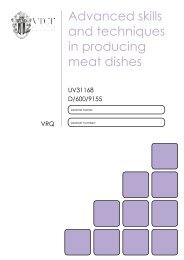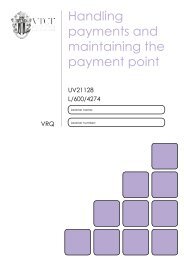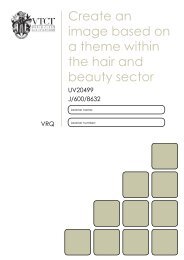Set and dress hair
Set and dress hair
Set and dress hair
Create successful ePaper yourself
Turn your PDF publications into a flip-book with our unique Google optimized e-Paper software.
US2GH11<br />
<strong>Set</strong> <strong>and</strong> <strong>dress</strong> <strong>hair</strong><br />
Through this unit you will develop the skill of setting <strong>and</strong><br />
<strong>dress</strong>ing techniques on a variety of <strong>hair</strong> types <strong>and</strong> lengths.<br />
Being able to identify the capability of your clients <strong>hair</strong><br />
will allow you to choose from a range of products, tools<br />
<strong>and</strong> equipment to complete the look. You will need to<br />
demonstrate the ability to use heated styling equipment<br />
to finish the service. Part of this service is to provide your<br />
client with good aftercare advice.<br />
US2GH11_v6
NOS<br />
GH11<br />
SCQF Level<br />
5<br />
SCQF Credit points<br />
6<br />
Observations<br />
3<br />
External paper(s)<br />
1
<strong>Set</strong> <strong>and</strong> <strong>dress</strong> <strong>hair</strong><br />
Learning outcomes<br />
On completion of this unit you will:<br />
1. Be able to use effective <strong>and</strong> safe working<br />
methods when setting <strong>and</strong> <strong>dress</strong>ing <strong>hair</strong><br />
2. Be able to set <strong>hair</strong><br />
3. Be able to <strong>dress</strong> <strong>hair</strong><br />
4. Know salon <strong>and</strong> legal requirements<br />
5. Know how to work safely, effectively <strong>and</strong><br />
hygienically when setting <strong>and</strong> <strong>dress</strong>ing <strong>hair</strong><br />
6. Underst<strong>and</strong> the basic science of setting <strong>and</strong><br />
<strong>dress</strong>ing <strong>hair</strong><br />
7. Know about products, equipment <strong>and</strong> their<br />
use<br />
8. Know about setting <strong>and</strong> <strong>dress</strong>ing<br />
techniques <strong>and</strong> effects<br />
9. Know about aftercare advice for clients<br />
Evidence requirements<br />
1. Simulation is not allowed for any<br />
performance evidence within this unit.<br />
2. You must practically demonstrate in your<br />
everyday work that you have met the<br />
st<strong>and</strong>ard for setting <strong>and</strong> <strong>dress</strong>ing <strong>hair</strong>.<br />
3. Your assessor will observe your<br />
performance on at least 3 occasions<br />
which must include observation of a:<br />
• curled effect<br />
• smooth effect<br />
• rolled effect.<br />
At least one of the observations must be<br />
of a set using rollers secured with pins.<br />
4. From the range, you must show that you<br />
have:<br />
• used 4 out of the 7* products<br />
• used all the types of tools <strong>and</strong> equipment<br />
• used all the setting techniques<br />
• set all <strong>hair</strong> types<br />
• used all the sectioning <strong>and</strong> winding<br />
techniques<br />
• taken into account all factors<br />
• used all the <strong>dress</strong>ing techniques <strong>and</strong><br />
created all the effects<br />
• given all the advice.<br />
* However, you must prove to your<br />
assessor that you have the necessary<br />
knowledge, underst<strong>and</strong>ing <strong>and</strong> skills to be<br />
able to perform competently in respect of<br />
all items in this range.<br />
5. It is likely most evidence of your<br />
performance will be gathered from the<br />
observations made by your assessor but<br />
you may be required to produce other<br />
evidence to support your performance if<br />
your assessor has not been present.<br />
6. Knowledge <strong>and</strong> underst<strong>and</strong>ing in this unit<br />
will be assessed by an external paper.<br />
The criteria that make up this paper are<br />
highlighted in white throughout this unit.<br />
There is one external paper that must be<br />
achieved.<br />
UN2GH11 3
4<br />
Achieving observations<br />
<strong>and</strong> range<br />
Achieving observation outcomes<br />
Your assessor will observe your performance<br />
of practical tasks. The minimum number<br />
of observations required is indicated in the<br />
evidence requirements section of this unit.<br />
Criteria may not always naturally occur during<br />
a practical observation. In such instances you<br />
will be asked questions to demonstrate your<br />
competence in this area. Your assessor will<br />
document the criteria that have been achieved<br />
through oral questioning.<br />
Your assessor will sign off an outcome when all<br />
criteria have been competently achieved in a<br />
single client service.<br />
Achieving range<br />
The range section indicates what must<br />
be covered. Ranges must be practically<br />
demonstrated as part of an observation. Your<br />
assessor will document the portfolio reference<br />
once a range has been competently achieved.<br />
UN2GH11<br />
Maximum service times<br />
The following maximum service times apply to<br />
this unit:<br />
<strong>Set</strong> <strong>and</strong> <strong>dress</strong> above<br />
shoulder length<br />
(excluding drying) 35 minutes<br />
<strong>Set</strong> <strong>and</strong> <strong>dress</strong> below<br />
shoulder length<br />
(excluding drying) 45 minutes
Outcome 1<br />
You can:<br />
a. Protect the client’s clothing throughout the<br />
service<br />
b. Use personal protective equipment when<br />
required<br />
c. Clean <strong>and</strong> tidy the work area throughout the<br />
service<br />
d. Position client <strong>and</strong> adopt postures that<br />
minimise fatigue, discomfort <strong>and</strong> injury risk<br />
e. Use working methods that:<br />
− minimise the wastage of products<br />
− minimise the risk of damage to tools<br />
<strong>and</strong> equipment<br />
− minimise the risk of cross-infection<br />
− make effective use of the working time<br />
− ensure the use of clean resources<br />
− minimise the risk of harm or injury to<br />
self <strong>and</strong> clients<br />
*May be assessed through oral questioning.<br />
Observations<br />
Be able to use effective <strong>and</strong> safe working methods when<br />
setting <strong>and</strong> <strong>dress</strong>ing <strong>hair</strong><br />
Observation 1 2 3<br />
Criteria questioned orally<br />
Date achieved<br />
Portfolio reference<br />
Learner signature<br />
Assessor initials<br />
f. Maintain personal st<strong>and</strong>ards of health <strong>and</strong><br />
hygiene which minimise the risk of crossinfection,<br />
infestation <strong>and</strong> offence to your<br />
clients <strong>and</strong> colleagues<br />
g. Use safe <strong>and</strong> suitable tools, equipment,<br />
techniques <strong>and</strong> products based on<br />
consultation with the client<br />
h. Use tests to check the temperature<br />
of heated equipment prior to use <strong>and</strong><br />
continually throughout the service<br />
i. Clean tools <strong>and</strong> equipment so they are free<br />
of product build up<br />
j. Complete the setting <strong>and</strong> <strong>dress</strong>ing service in<br />
a commercially viable time<br />
UN2GH11 5
6<br />
Outcome 2<br />
Be able to set <strong>hair</strong><br />
You can:<br />
a. Confirm the agreed look with the client<br />
during consultation prior to commencing the<br />
cut<br />
b. Control tools <strong>and</strong> equipment to minimise<br />
the risk of damage to the <strong>hair</strong> <strong>and</strong> scalp <strong>and</strong><br />
client discomfort<br />
c. Use meshes of <strong>hair</strong> which suit the size of<br />
the tools <strong>and</strong> equipment<br />
d. Use sectioning <strong>and</strong> winding techniques to<br />
achieve the desired look<br />
e. Secure wound rollers so they sit on or off<br />
base to meet the style requirements<br />
f. Maintain the tension throughout the setting<br />
process<br />
*May be assessed through oral questioning.<br />
Observation 1 2 3<br />
Criteria questioned orally<br />
Date achieved<br />
Portfolio reference<br />
Learner signature<br />
Assessor initials<br />
UN2GH11<br />
g. Maintain damp <strong>hair</strong> throughout the setting<br />
process, when required<br />
h. Apply suitable products according to<br />
manufacturers’ instructions *<br />
i. Control the client’s <strong>hair</strong> throughout the<br />
setting process taking account of influencing<br />
factors<br />
j. Remove items used for setting, avoiding<br />
discomfort to the client<br />
k. Confirm that the setting techniques achieve<br />
the desired look
Outcome 3<br />
Be able to <strong>dress</strong> <strong>hair</strong><br />
You can:<br />
a. Remove all section marks from the client’s<br />
<strong>hair</strong><br />
b. Use heated equipment at the correct<br />
temperature for the client’s <strong>hair</strong> <strong>and</strong> the<br />
desired look<br />
c. Control tools <strong>and</strong> equipment to minimise<br />
the risk of damage to the <strong>hair</strong> <strong>and</strong> scalp <strong>and</strong><br />
client discomfort<br />
d. Secure the <strong>hair</strong> so that pins <strong>and</strong> grips are<br />
not visible*<br />
*May be assessed through oral questioning.<br />
Observation 1 2 3<br />
Criteria questioned orally<br />
Date achieved<br />
Portfolio reference<br />
Learner signature<br />
Assessor initials<br />
e. Apply <strong>and</strong> use suitable products according<br />
to manufacturers’ instructions<br />
f. Check that the finished look achieves the<br />
intended shape, direction <strong>and</strong> volume<br />
agreed with the client, taking account of<br />
influencing factors<br />
g. Confirm the client’s satisfaction with the<br />
finished look<br />
h. Provide the client with suitable aftercare<br />
advice<br />
UN2GH11 7
8<br />
Range<br />
You must practically demonstrate that you have:<br />
Used 4 out of 7 products Portfolio reference<br />
<strong>Set</strong>ting lotion<br />
Gel<br />
Mousse<br />
Serums<br />
Creams<br />
Sprays<br />
Wax<br />
Used all tools <strong>and</strong> equipment Portfolio reference<br />
Rollers<br />
Combs<br />
Pin curl clips<br />
Brushes<br />
Grips <strong>and</strong> pins<br />
Heated rollers<br />
Tongs<br />
Straighteners<br />
Used all setting techniques Portfolio reference<br />
Rollering<br />
Spiral curling<br />
Pin curling to give volume<br />
Pin curling to give flat movement<br />
UN2GH11
You must practically demonstrate that you have:<br />
<strong>Set</strong> all <strong>hair</strong> types Portfolio reference<br />
Above shoulder length<br />
Maximum service time to set & <strong>dress</strong> (excluding drying) - 35 mins<br />
Below shoulder length<br />
Maximum service time to set & <strong>dress</strong> (excluding drying) - 45 mins<br />
Used all sectioning <strong>and</strong> winding techniques Portfolio reference<br />
Point to root<br />
Root to point<br />
On base<br />
Off base<br />
Directional<br />
Brick<br />
Taken into account all factors Portfolio reference<br />
Hair cut<br />
Hair growth pattern<br />
Hair length<br />
Hair density<br />
Head <strong>and</strong> face shape<br />
Hair texture<br />
Hair elasticity<br />
The occasion for which the style is required<br />
UN2GH11 9
10<br />
You must practically demonstrate that you have:<br />
Used all <strong>dress</strong>ing techniques <strong>and</strong> created all effects Portfolio reference<br />
Curls<br />
Rolls<br />
Smoothing<br />
Back-combing<br />
Back-brushing<br />
Given all the advice Portfolio reference<br />
Suitable aftercare products <strong>and</strong> their use<br />
Use of heated styling equipment<br />
How to recreate <strong>and</strong> maintain the style<br />
UN2GH11
Achieving knowledge outcomes<br />
You will be guided by your tutor <strong>and</strong> assessor<br />
on the evidence that needs to be produced.<br />
Your knowledge <strong>and</strong> underst<strong>and</strong>ing will be<br />
assessed using the assessment methods listed<br />
below:<br />
• Observed work<br />
• Witness statements<br />
• Audio-visual media<br />
• Evidence of prior learning or attainment<br />
• Written questions<br />
• Oral questions<br />
• Assignments<br />
• Case studies<br />
Achieving the external paper<br />
Developing knowledge<br />
Where possible your assessor will integrate<br />
knowledge outcomes into practical observations<br />
through oral questioning.<br />
The external paper will test your knowledge of the criteria highlighted in white. A pass mark of<br />
70% must be achieved. Criteria not achieved will be identified to your tutor/assessor. You will<br />
then e orally questioned or asked to produce other forms of evidence as all unit criteria must be<br />
achieved.<br />
Your assessor will complete the table below when the 70% pass mark has been achieved.<br />
Paper Date achieved Assessor initials<br />
1 of 1<br />
UN2GH11 11
12<br />
Knowledge<br />
Outcome 4<br />
Know salon <strong>and</strong> legal requirements<br />
You can:<br />
a. Describe the salon's requirements for client preparation<br />
b. Describe the salon's expected service times for cutting <strong>hair</strong><br />
c. State personal responsibilities under current regulations in relation<br />
to setting <strong>and</strong> <strong>dress</strong>ing services:<br />
− Control of Substances Hazardous to Health Regulations<br />
− Electricity at Work Regulations<br />
* Assessor initials to be inserted if orally questioned.<br />
Requirements highlighted in white are assessed in the external paper.<br />
UN2GH11<br />
Portfolio reference /<br />
Assessor initials*
Outcome 5<br />
Know how to work safely, effectively <strong>and</strong> hygienically when<br />
setting <strong>and</strong> <strong>dress</strong>ing <strong>hair</strong><br />
You can:<br />
a. Outline the types of personal protective equipment available for<br />
clients <strong>and</strong> yourself, <strong>and</strong> its importance<br />
b. Describe contact dermatitis <strong>and</strong> state how to avoid developing it<br />
during the setting <strong>and</strong> <strong>dress</strong>ing service<br />
c. Describe how own <strong>and</strong> client positioning can affect the desired<br />
outcome <strong>and</strong> reduce fatigue <strong>and</strong> injury risk<br />
d. Describe why it is important to position tools <strong>and</strong> equipment for<br />
ease of use<br />
e. Outline the safety considerations which must be taken into account<br />
when setting <strong>and</strong> <strong>dress</strong>ing <strong>hair</strong><br />
f. Describe why it is important to keep the work area clean <strong>and</strong> tidy<br />
g. Compare safe <strong>and</strong> hygienic working methods that minimise the<br />
risk of cross-infection <strong>and</strong> cross-infestation<br />
h. Describe the importance of personal hygiene<br />
i. Outline the importance of using products economically<br />
j. State why it is important to check electrical equipment used to aid<br />
setting <strong>and</strong> <strong>dress</strong>ing processes<br />
k. Describe the reasons why tools <strong>and</strong> equipment should be kept free<br />
from excess oils, product build up <strong>and</strong> <strong>hair</strong><br />
* Assessor initials to be inserted if orally questioned.<br />
Requirements highlighted in white are assessed in the external paper.<br />
Portfolio reference /<br />
Assessor initials*<br />
UN2GH11 13
14<br />
Outcome 6<br />
Underst<strong>and</strong> the basic science of setting <strong>and</strong> <strong>dress</strong>ing <strong>hair</strong><br />
You can:<br />
a. Describe the effects of humidity on <strong>hair</strong><br />
b. Describe the physical effects of setting on <strong>hair</strong> structure<br />
c. Explain how the incorrect application of heat can affect the <strong>hair</strong><br />
<strong>and</strong> scalp<br />
d. Explain why <strong>hair</strong> should be allowed to cool prior to <strong>dress</strong>ing<br />
e. Explain why <strong>hair</strong> should be kept damp during the setting process<br />
f. Explain how heat protectors act to protect the <strong>hair</strong><br />
* Assessor initials to be inserted if orally questioned.<br />
Requirements highlighted in white are assessed in the external paper.<br />
UN2GH11<br />
Portfolio reference /<br />
Assessor initials*
Outcome 7<br />
Know about products, equipment <strong>and</strong> their use<br />
You can:<br />
a. Compare different types of tools, equipment <strong>and</strong> products available<br />
for setting <strong>and</strong> <strong>dress</strong>ing<br />
b. Describe the importance of following manufacturers’ instructions<br />
for setting <strong>and</strong> <strong>dress</strong>ing products in the salon<br />
c. Describe the use of different tools, equipment <strong>and</strong> products for<br />
setting <strong>and</strong> <strong>dress</strong>ing <strong>hair</strong><br />
* Assessor initials to be inserted if orally questioned.<br />
Requirements highlighted in white are assessed in the external paper.<br />
Portfolio reference /<br />
Assessor initials*<br />
UN2GH11 15
16<br />
Outcome 8<br />
Know about setting <strong>and</strong> <strong>dress</strong>ing techniques <strong>and</strong> effects<br />
You can:<br />
a. Describe the use of current techniques for setting <strong>and</strong> <strong>dress</strong>ing<br />
<strong>hair</strong><br />
b. Describe how different factors affect the setting <strong>and</strong> <strong>dress</strong>ing<br />
processes <strong>and</strong> the finished look<br />
c. Compare the use the different types of sectioning <strong>and</strong> winding<br />
techniques<br />
d. Describe why <strong>and</strong> how to use smoothing, back-combing <strong>and</strong> backbrushing<br />
techniques<br />
e. Describe how the angle of winding on <strong>and</strong> off base influences the<br />
volume <strong>and</strong> direction of the <strong>hair</strong> movement<br />
f. Describe why set <strong>hair</strong> sections need to be brushed out thoroughly<br />
g. Describe methods of h<strong>and</strong>ling, controlling <strong>and</strong> securing <strong>hair</strong> to<br />
achieve curls <strong>and</strong> rolls<br />
* Assessor initials to be inserted if orally questioned.<br />
Requirements highlighted in white are assessed in the external paper.<br />
UN2GH11<br />
Portfolio reference /<br />
Assessor initials*
Outcome 9<br />
Know about aftercare advice for clients<br />
You can:<br />
a. Compare suitable <strong>and</strong> unsuitable products for the client’s home<br />
use <strong>and</strong> the reasons<br />
b. Describe how the continual use of heated equipment can affect the<br />
<strong>hair</strong><br />
c. Describe the different ways of maintaining a style<br />
* Assessor initials to be inserted if orally questioned.<br />
Requirements highlighted in white are assessed in the external paper.<br />
Portfolio reference /<br />
Assessor initials*<br />
UN2GH11 17
18<br />
UN2GH11<br />
Notes<br />
Use this area for making notes <strong>and</strong> drawing diagrams


